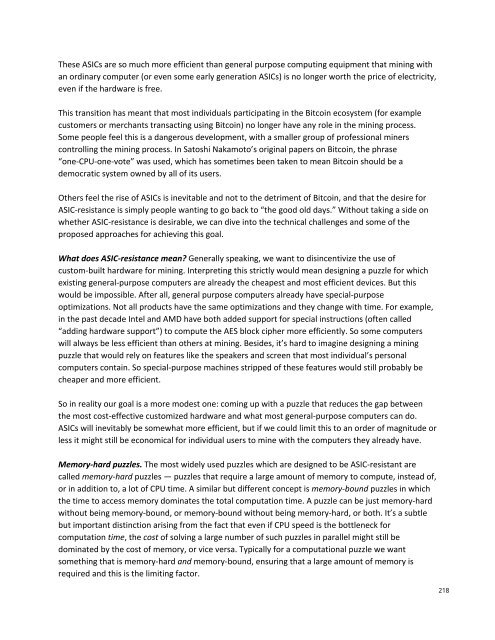Bitcoin and Cryptocurrency Technologies
1Qqc4BN
1Qqc4BN
You also want an ePaper? Increase the reach of your titles
YUMPU automatically turns print PDFs into web optimized ePapers that Google loves.
These ASICs are so much more efficient than general purpose computing equipment that mining with<br />
an ordinary computer (or even some early generation ASICs) is no longer worth the price of electricity,<br />
even if the hardware is free.<br />
This transition has meant that most individuals participating in the <strong>Bitcoin</strong> ecosystem (for example<br />
customers or merchants transacting using <strong>Bitcoin</strong>) no longer have any role in the mining process.<br />
Some people feel this is a dangerous development, with a smaller group of professional miners<br />
controlling the mining process. In Satoshi Nakamoto’s original papers on <strong>Bitcoin</strong>, the phrase<br />
“one‐CPU‐one‐vote” was used, which has sometimes been taken to mean <strong>Bitcoin</strong> should be a<br />
democratic system owned by all of its users.<br />
Others feel the rise of ASICs is inevitable <strong>and</strong> not to the detriment of <strong>Bitcoin</strong>, <strong>and</strong> that the desire for<br />
ASIC‐resistance is simply people wanting to go back to “the good old days.” Without taking a side on<br />
whether ASIC‐resistance is desirable, we can dive into the technical challenges <strong>and</strong> some of the<br />
proposed approaches for achieving this goal.<br />
What does ASIC‐resistance mean?Generally speaking, we want to disincentivize the use of<br />
custom‐built hardware for mining. Interpreting this strictly would mean designing a puzzle for which<br />
existing general‐purpose computers are already the cheapest <strong>and</strong> most efficient devices. But this<br />
would be impossible. After all, general purpose computers already have special‐purpose<br />
optimizations. Not all products have the same optimizations <strong>and</strong> they change with time. For example,<br />
in the past decade Intel <strong>and</strong> AMD have both added support for special instructions (often called<br />
“adding hardware support”) to compute the AES block cipher more efficiently. So some computers<br />
will always be less efficient than others at mining. Besides, it’s hard to imagine designing a mining<br />
puzzle that would rely on features like the speakers <strong>and</strong> screen that most individual’s personal<br />
computers contain. So special‐purpose machines stripped of these features would still probably be<br />
cheaper <strong>and</strong> more efficient.<br />
So in reality our goal is a more modest one: coming up with a puzzle that reduces the gap between<br />
the most cost‐effective customized hardware <strong>and</strong> what most general‐purpose computers can do.<br />
ASICs will inevitably be somewhat more efficient, but if we could limit this to an order of magnitude or<br />
less it might still be economical for individual users to mine with the computers they already have.<br />
Memory‐hard puzzles.The most widely used puzzles which are designed to be ASIC‐resistant are<br />
called memory‐hardpuzzles — puzzles that require a large amount of memory to compute, instead of,<br />
or in addition to, a lot of CPU time. A similar but different concept is memory‐boundpuzzles in which<br />
the time to access memory dominates the total computation time. A puzzle can be just memory‐hard<br />
without being memory‐bound, or memory‐bound without being memory‐hard, or both. It’s a subtle<br />
but important distinction arising from the fact that even if CPU speed is the bottleneck for<br />
computation time, the costof solving a large number of such puzzles in parallel might still be<br />
dominated by the cost of memory, or vice versa. Typically for a computational puzzle we want<br />
something that is memory‐hard <strong>and</strong>memory‐bound, ensuring that a large amount of memory is<br />
required <strong>and</strong> this is the limiting factor.<br />
218









